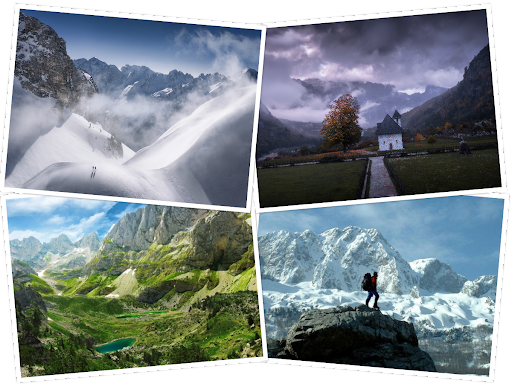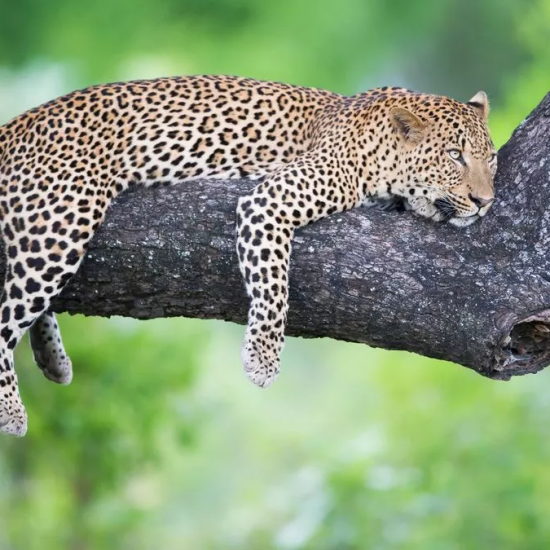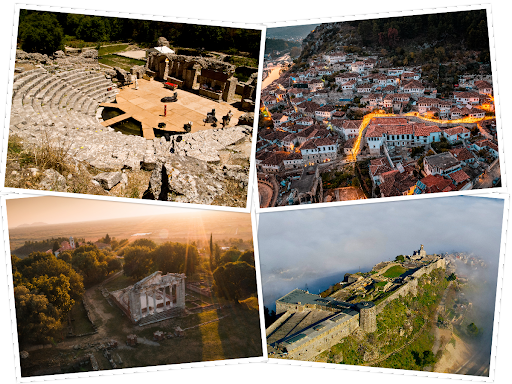
Four-Day Tour in the Albanian Alps
Tirana – Theth – Shkodra – Vermosh – Razem – Boge – Valbona Valley
During this four-day tour, you will have the opportunity to explore one of the most beautiful regions of Albania, the Albanian Alps, located in the northern part of the country, in the Shkodra region. The stunning nature of the Albanian mountain ranges, clean air, dense forests, alpine meadows, and meandering rivers are among the most captivating attractions that Northern Albania offers. The touristic villages in the Alps, the National Park of the Alps, Valbona Valley, and the breathtaking views of Theth, along with the canyons formed there and the historic city of Shkodra, make it a touristic destination not only dedicated to mountain tourism but can be visited in four-seasons.
Day 1: Tirana – Theth
Departure for Theth in the early morning. After a few kilometers of traveling, there will be a brief stop at Qafe Thore, where you will find a beautiful restaurant made of wood and stone, allowing you to admire the rugged mountains and beautiful valleys. Afterwards, we will visit the Church of Theth, built in 1892 and renovated in 2005, a well-known panorama photographed by all Albanian and foreign travelers who have encountered it in their adventures in the Albanian Alps.
During the hike, you will notice characteristic houses like towers, leading to the “Ngujimi” Tower. Departing from the village, near the old Theth mill, you can take the trail that surprises you with the magical view of the Theth Canyon, the Waterfall, and the Gerla Bridge. Theth is covered with massive beech trees, covering almost 90% of the park’s area. The eye will also be delighted with the beautiful view of flowers, among with the “Wulfenia Baldacci”, discovered by the Italian botanist Baldacci, stands out. The entire day is spent in Theth to enjoy the traditional dinner offered in the area and accommodation in Theth.
Day 2: Theth – Grunas Canyon – Shkodra
On the second day of the journey, you can explore the Grunas Canyon, surrounded by an inspiring environment for anyone who visits. After a short stop at this attraction, you can visit one of Albania’s well-preserved treasures, the Blue Eye of Theth, a natural attraction in an elliptical shape characterized by deep blue shades that evoke the structure of an eye. Here, you can also have lunch in the lap of nature at a local guesthouse.
In the afternoon, head towards Shkodra to explore its historic fortress, the beautiful Rozafa Castle, which seems to suspend between history and legend. Shkodra is one of the oldest cities in Albania, founded in the 4th century BC as the capital of the Illyrian tribe of Labeates. Throughout its history, it has experienced numerous invasions, such as Roman (168 B.C.), Serbian (1040), Venetian (1396), and Ottoman (1479) occupations. Later, it became the center of the feudal principality of the Balshas in the 14th century and the capital of the Pashalik of Bushatlis during the years 1757-1831. Shkodra is considered one of the cities with rich cultural heritage, being the birthplace of the most known artists, musicians, painters, photographers, poets, and writers. The main tourist attraction of the city is Rozafa Castle, which rises on a rocky hill west of the city, surrounded by the waters of three rivers: Drini, Buna, and Kir. The castle has Illyrian origins, and according to popular tales, Rozafa, the youngest bride of three brothers who raised the castle walls, was walled up to allow the castle to be built. The crystal-clear water that flows at the entrance of the castle is also linked to the popular legend, suggesting it is Rozafa’s breast milk, left outside during the walling to feed her baby.
The castle’s current form dates back to the Balsha rule. Other attractions to visit in Shkodra are the Historical Museum, the former house of Oso Kuka, Marubi Photography, the Clock Tower, or the Englishman’s Tower, traditional neighborhoods of Gjuhadol and Serreq with Venetian architecture. Close to the city is Lake Shkodra, the largest in the Balkan Peninsula, with an area of 368 km2, of which 149 km2 belong to Albania. In the southern part of the lake are two main tourist centers, Shiroka and Zogaj.
Shiroka is linked to Saint Rrok, in whose honor a pilgrimage is organized every August 15. According to tradition, swimming in the lake is prohibited after August 15. The main specialty is the trout dish.
Additionally, during your visit to Shkodra, in the northern part near the lake, you will find picturesque villages such as Jubica, Fllaka, and Kalldruni. Located 9 km from the city of Shkodra is the medieval town of Sarda, situated on the island of Shurdhah, near the artificial lake of Vau i Dejes. This town is known as the residence of the feudal Dukagjini family and was an important cultural center until the 15th century. To visit this place, you need to book a boat trip from the Vau i Dejes dam. On the island, you can explore the church walls and the castle gate, including the Church of Zojas. A beautiful experience is a boat trip to this natural and cultural attraction, offering opportunities for fishing and canoeing. The climate of Lake Shkodra is warm, with 250-260 sunny days per year. The main activities are swimming and boating. Besides this potential, Lake Shkodra is also an important natural ecosystem, hosting 281 bird species and 45 fish species, with the most important being carp.
Days 3 and 4: Shkodra – Vermosh – Razma – Boge – Valbona Valley
Another fantastic attraction in the region of the Western Alps is Vermoshi, which also represents the northernmost area of Albania. Vermoshi is located 95 km away from the city of Shkodra. During the journey, you will encounter Qafa e Rrapshit, from where the Cemi River with its clear waters is distinguished, contrasting beautifully with the green landscape in spring. During the summer, the small pools created by the river can be used for sunbathing. Vermoshi is part of the Kelmendi region, a name that comes from the Latin word “Clemens,” meaning wise or simple. Vermoshi is situated in a mountainous field at an altitude of 1,100 m above sea level, under the high slopes of the Alps. In Vermoshi, various nature activities can be enjoyed, such as climbing, trekking, skiing, and hunting for wildlife.
The alpine tour continues with the Razma mountainous tourist village located in the Western Alps. Here, you will experience a journey like no other, amidst ancient legends from the time of Homer to the present day. The road to this high-mountain area starts from the city of Shkodra, and Razma is 41 km away, situated at the foot of the Veleciku mountain, a fantastic area covered with pine and beech forests. Simultaneously, rare alpine flowers enhance the landscape. One of Razma’s unique features, despite heavy snowfall, is that it doesn’t get blocked, making it accessible throughout the winter.
Accommodation is available in the built hotels of the area, and activities include excursions, cave exploration, mountain climbing, tourism with tents (during summer), and skiing.
The next stop is Boge. From Razma, take the road to the village of Dedaj and then to the Bogë point, located between the Alps and vividly described by the famous English traveler Edith Durham in her book “Albania, the Burden of the Balkans.” Bogë offers opportunities for various activities such as mountain climbing, skiing, and especially speleology, known as cave exploration tourism. Notable caves include the Mulliri Cave, Akullore Cave, Njerëzve të Lagun Cave, and more. Particularly unique is the Puci Cave, situated at an altitude of 1087 m above sea level, rich in stalactites, stalagmites, and wall veils.
The Valbona Valley is another beautiful attraction in the Albanian Alps, extending in their eastern part. It is one of the most beautiful natural areas in Albania, declared a National Park, covering an area of 8,000 hectares. Valbona stretches across the territories between Albania, Kosovo, and Montenegro. The distance from the alpine city of Bajram Curri to the National Park of Valbona is 27 km. Before visiting the Valbona River Valley, you will encounter the Shoshani source, located just 3 km from the city of Bajram Curri. In the Valbona River, a karstic source pours into a captivating canyon with a width of 2-3 meters and a depth of 50 meters. During the visit to the Valbona Valley, you will pass through several characteristic alpine villages such as Dragobia, known for its alpine-style houses, Valbona (or Selimaj), located 25 km from the city of Bajram Curri, and the last village before the Valbona source, Rrogami. Here, you can stay in the homes of locals or a hotel, enjoying characteristic dishes such as “mazja,” “flija,” “pitja,” etc.
The entire valley is distinguished by strong color palettes and rare beauty, where crystal-clear waters of Valbona and the steep slopes of the mountains covered with greenery enhance the scenery. During winter, this area is covered in snow.
In the Valbona National Park, various nature activities can be carried out, such as excursions, trekking along the valley and waterfalls (Cerremit, Kukajve), canoeing in certain areas of the river, skiing, mountain climbing on the slopes of the mountains. Additionally, Valbona can serve as a base for climbing Mount Jezerca (the second-highest peak in Albania after Korab), horseback riding along the river valley, as well as sports fishing. In the northern part of the Valbona Park, is located the Gashi River Valley, recognized as a protected area by UNESCO. The main attractions here are the glacial lakes of Doberdol valley and Sylbica. This location you can reach by a horse ride during the summer season.



